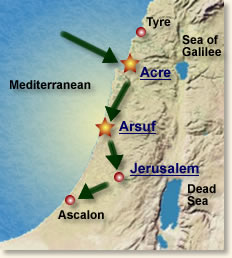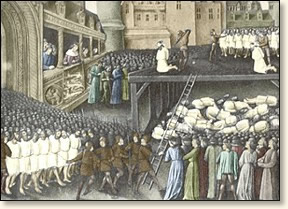|
Richard The Lionheart Massacres
The Saracens, 1191
In the year 1187, the Muslim leader Saladin re-conquered the city of Jerusalem [see "The Crusaders Capture Jerusalem"] as well as most of the Crusader strongholds throughout the Holy Land. In response, the kings of Europe including Frederick Babarossa of Germany (who died on route), Phillip of France and Richard I of England (the Lionheart) mounted a campaign to rescue the city. The Third Crusade was underway.
Key to the campaign's success was the capture of the port city of Acre. King
Richard arrived on the scene in June 1191 to find the city under siege by a
Christian army. In the distance, Saladin threatened - his army too weak to
overwhelm the besiegers, but too strong to be dislodged.

Richard's progress through the Holy Land
Click underlined items for more information |
Intensifying the bombardment
of the city, Richard and the French King, Phillip, slowly broke the city's
walls, weakening its defenses while simultaneously starving the occupiers into
submission. Finally, on July 12, the Muslim defenders and Crusaders agreed
to surrender terms. In exchange for sparing the lives of the defenders, Saladin
would pay a ransom of 200,000 gold pieces, release some 1500 Christian prisoners
and return the Holy Cross. These actions were to be accomplished within one
month after the fall of the city. Richard would hold 2,700 Muslim prisoners
as hostage until the terms were met.
Saladin immediately ran into problems meeting his part of the bargain and the deadline came without payment of the terms. As a compromise, Saladin proposed that Richard release his prisoners in return for part of the ransom with the remainder to be paid at a later date. Saladin would provide hostages to Richard to assure payment. Alternatively, he proposed to give Richard what money he had and allow Richard to keep the prisoners in return for Christian hostages to be held until the remainder of the money was raised and the Muslim prisoners released. Richard countered that he would accept the partial payment but Saladin must accept his royal promise to release his prisoners when he received the remainder of the ransom. Neither ruler would accept his opponent's terms. Richard declared the lives of the Muslim defenders of Acre forfeit and set August 20 as the date for their execution.
Beha-ed-Din was a member of Saladin's court and (along with much of the Saracen army who watched from a distance) witnessed the massacre of 2,700 of his comrades:
"Then the king of England, seeing all the delays interposed by the Sultan to the execution of the treaty, acted perfidiously as regards his Musulinan prisoners. On their yielding the town he had engaged to grant their life, adding that if the Sultan carried out the bargain he would give them freedom and suffer them to carry off their children and wives; if the Sultan did not fulfill his engagements they were to be made slaves. Now the king broke his promises to them and made open display of what he had till now kept hidden in his heart, by carrying out what he had intended to do after he had received the money and the Frank prisoners. It is thus that people of his nation ultimately admitted.
In the afternoon of Tuesday, 27 Rajab, [August 20] about four o'clock, he came out on horseback with all the Frankish army, knights, footmen, Turcoples, and advanced to the pits at the foot of the hill of Al 'Ayadiyeh, to which place be had already sent on his tents. The Franks, on reaching the middle of the plain that stretches between this hill and that of Keisan, close to which place the sultan's advanced guard had drawn back, ordered all the Musulman

Richard watches the massacre
From a 15th century illustration |
prisoners, whose martyrdom God had decreed for this day, to be brought before him. They numbered more than three thousand and were all bound with ropes. The Franks then flung themselves upon them all at once and massacred them with sword and lance in cold blood. Our advanced guard had already told the Sultan of the enemy's movements and he sent it some reinforcements, but only after the massacre. The Musulmans, seeing what was being done to the prisoners, rushed against the Franks and in the combat, which lasted till nightfall, several were slain and wounded on either side. On the morrow morning our people gathered at the spot and found the Musulmans stretched out upon the ground as martyrs for the faith. They even recognised some of the dead, and the sight was a great affliction to them. The enemy had only spared the prisoners of note and such as were strong enough to work.
The motives of this massacre are differently told; according to some, the captives were slain by way of reprisal for the death of those Christians whom the Musulmans had slain. Others again say that the king of England, on deciding to attempt the conquest of Ascalon, thought it unwise to leave so many prisoners in the town after his departure. God alone knows what the real reason was.
"
References:
Beha-ed-Din, his account appears in Archer, T.A., The Crusade of Richard I (1889); Gillingham, John, The Life and Times of Richard I (1973).
How To Cite This Article:
"Richard The Lionheart Massacres The Saracens, 1191," EyeWitness to History, www.eyewitnesstohistory.com (2001).
|






